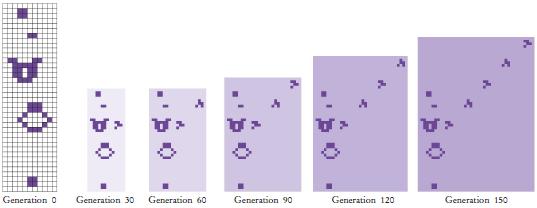The Game of Life is a well-known mathematical game that gives rise to amazingly complex behavior, although
Question:
The Game of Life is a well-known mathematical game that gives rise to amazingly complex behavior, although it can be specified by a few simple rules. (It is not actually a game in the traditional sense, with players competing for a win.) Here are the rules. The game is played on a rectangular board. Each square can be either empty or occupied. At the beginning, you can specify empty and occupied cells in some way; then the game runs automatically. In each generation, the next generation is computed. A new cell is born on an empty square if it is surrounded by exactly three occupied neighbor cells. A cell dies of overcrowding if it is surrounded by four or more neighbors, and it dies of loneliness if it is surrounded by zero or one neighbor. A neighbor is an occupant of an adjacent square to the left, right, top, or bottom or in a diagonal direction. Figure 20 shows a cell and its neighbor cells. 
Many configurations show interesting behavior when subjected to these rules. Figure 21 shows a glider, observed over five generations. After four generations, it is transformed into the identical shape, but located one square to the right and below.

One of the more amazing configurations is the glider gun: a complex collection of cells that, after 30 moves, turns back into itself and a glider (see Figure 22). Program the game to eliminate the drudgery of computing successive generations by hand. Use a two-dimensional array to store the rectangular configuration. Write a program that shows successive generations of the game. Ask the user to specify the original configuration, by typing in a configuration of spaces and o characters.

Step by Step Answer:






